Welcome to your guide on Essential Tools for Paint Pouring. Discover the must-have tools for creating mesmerizing paint pour art. Learn about setting up your art space, perfecting paint mixing, and experimenting with techniques for stunning results. Elevate your paint-pouring experience with practical tips and tool recommendations. Start your artistic journey with confidence by exploring everything you need to get started with paint pouring.
What is Paint Pouring?
Paint pouring, also known as fluid art, is a form of abstract art that involves pouring paints of different colors on a canvas to create unique patterns. Unlike traditional painting, which uses brushes, paint pouring is more free-flowing and allows the paints to blend and mix naturally, resulting in organic shapes and unexpected designs. This technique is accessible to artists of all skill levels and has become increasingly popular for its mesmerizing and unpredictable results.
Why Do You Need Specific Tools for Paint Pouring?
Before you start grabbing household items or traditional painting tools, it’s crucial to understand that paint pouring requires specific materials to achieve the best results. The unique properties of fluid art, such as the flow and blend of paints, necessitate specialized tools to create those stunning effects. Using the right tools ensures that your paint pours are not only beautiful but also durable and well-constructed.
Basic Tools and Materials
Canvas and Surfaces
Choosing the right canvas or surface is the first step in your paint pouring journey. Canvases designed for acrylic paints are typically recommended, but other surfaces like wood panels, tiles, and even glass can be used for different effects.
Canvas Types
| Type | Description | Pros | Cons |
|---|---|---|---|
| Stretched Canvas | Pre-stretched and mounted on a wooden frame | Ready to use, available in various sizes | Can be more expensive |
| Canvas Board | Canvas material mounted on a rigid board | More affordable, portable | May warp over time |
| Wooden Panels | Smooth wooden surfaces | Durable, can be custom-sized | Requires sealing/preparing |
| Tiles | Ceramic or porcelain tiles | Smooth, great for coasters | Limited in size |
| Glass | Smooth, allows for unique backlighting effects | Fragile, needs careful handling | Prone to breaking |
Paints and Additives
For paint pouring, acrylic paints are the go-to choice due to their vibrant colors and fluid consistency. However, you’ll also need various additives to control and enhance the flow.
Acrylic Paint
Acrylic paints provide strong colors and are durable when dried. It’s crucial to select high-quality acrylic paints to guarantee long-lasting and vibrant results.
Additives
Additives are substances mixed with paint to adjust their properties like viscosity, flow, and cell creation. Some common additives include:
- Pouring Medium: This fluid is designed to help acrylic paint flow more smoothly and evenly over the canvas.
- Silicone Oil: Used to create cells, which are those interesting, bubble-like shapes that appear within the paint.
- Distilled Water: Adding a small amount of water can thin the paint, but always use distilled water to avoid impurities that can affect the paint’s quality.
Mixing Tools
Mixing tools are essential to ensure that your paint mixtures are well-blended and free of clumps.
Types of Mixing Tools
- Plastic Cups: Ideal for mixing and pouring different colors of paint. Disposable options reduce cleanup time.
- Wooden Stir Sticks: Perfect for stirring paint and additives.
- Measuring Cups/Spoons: Accuracy is key in paint pouring, so having a set of measuring tools is incredibly useful.
Pouring Techniques
Different techniques in paint pouring can yield a variety of stunning effects. Here are some of the most popular methods:
Dirty Pour
In a dirty pour, you layer multiple colors of paint in a single cup before pouring it onto the canvas. This technique creates striking, multi-colored patterns and interesting blends.
Flip Cup
Similar to the dirty pour, but with a twist! After layering the colors in a cup, you invert the cup onto the canvas and then lift it. The paints spread out dramatically, resulting in a vibrant, concentric design.
Swipe Technique
In the swipe technique, you pour paint onto the canvas and then swipe a tool, like a palette knife or plastic card, across the surface. This method can produce beautiful feathered patterns and helps to bring out cells.
Essential Tools List
To streamline your paint pouring experience, here’s a list of the fundamental tools you’ll need:
Protective Gear
Paint pouring can get messy, so protective gear is crucial. Consider the following items:
- Gloves: To keep your hands clean and protect from chemicals in the paint.
- Apron or Old Clothes: To safeguard your clothing from spills and splatters.
- Goggles: To protect your eyes from accidental splashes.
Setup Tools
Setting up your workspace correctly is essential for a smooth painting process. Here are some vital setup tools:
- Drop Cloth or Plastic Sheet: To protect your work surface.
- Leveling Tool: Ensures your canvas is level, which affects how the paint settles.
- Plastic Elevators/Push Pins: Elevate your canvas to allow paint to drip off the edges and prevent sticking.
Application Tools
Different tools can help you apply and manipulate the paint in various ways:
- Palette Knives: Useful for spreading and swiping paint.
- Straws: For blowing paint to create delicate designs.
- Combs and Rakes: Create intricate patterns within the pour.
- Airbrush or Hairdryer: Speeds up drying and helps in manipulating the paint.

Preparing Your Workspace
Before diving into the creative process, preparing your workspace is crucial for both your convenience and safety. A well-organized workspace ensures that you have all your tools at hand and minimizes accidents and spills.
Selecting a Location
Choose a well-ventilated area to work in, as fumes from the paint and additives can be harmful. A garage, basement, or an outdoor area (weather permitting) can be ideal locations.
Protecting the Area
Cover your working surface with a drop cloth or plastic sheet to catch any drips and spills. If you’re working on a table, secure the covering with tape to prevent it from shifting.
Organizing Tools and Materials
Arrange all your materials within easy reach. Set up your canvases on a level surface, and ensure you have a place to set down tools without contaminating them with paint.
Step-by-Step Paint Pouring Process
Now that you know what tools you need and how to set up your workspace, let’s walk through the paint pouring process step-by-step.
Step 1: Prepare Your Canvas
Ensure your canvas is free of dust and grease. If using wooden panels or other porous surfaces, you may need to prime them with a sealant or gesso to prevent the paint from soaking in.
Step 2: Mix Your Paints
Combine your acrylic paints with a pouring medium, following the manufacturer’s recommended ratio. Use a separate cup for each color and mix thoroughly with a stir stick. Add any desired additives, like silicone oil, to create cells.
Example Mixture:
| Component | Ratio |
|---|---|
| Acrylic Paint | 1 Part |
| Pouring Medium | 1 Part |
| Silicone Oil | A few drops per cup |
Step 3: Choose Your Technique
Select your desired pouring technique (dirty pour, flip cup, swipe, etc.) and prepare your paint accordingly. For a dirty pour, layer your mixed paints in a larger cup without mixing them.
Step 4: Pour the Paint
Pour your paint onto the canvas using your chosen technique. Take your time to observe how the colors interact and adjust your movements to create the desired pattern.
Step 5: Manipulate the Paint
Use tools like palette knives, straws, or a hairdryer to further control the flow and shape of the paint. This step allows for personalization and experimentation.
Step 6: Let it Dry
Set your canvas on an elevated surface and cover it to protect from dust. Allow the paint to dry completely, which can take anywhere from 24-72 hours depending on the thickness of the paint layers and environmental conditions.
Sealing and Finishing
Once your masterpiece is dry, sealing it ensures the longevity and vibrancy of the colors.
Sealing Options
- Varnish: A clear acrylic varnish can be sprayed or brushed onto the canvas for a glossy finish.
- Resin: Provides a thick, glass-like finish that is extremely durable but requires careful mixing and application.
Application Tips
Follow the manufacturer’s instructions for your chosen sealant. Work in a well-ventilated area and wear protective gear to avoid inhaling fumes.
Troubleshooting Common Issues
Even with thorough preparation, you may encounter some challenges during your paint pouring journey. Here’s a quick guide to troubleshoot common issues:
| Issue | Possible Causes | Solutions |
|---|---|---|
| Paint Cracking | Paint layers too thick, or drying too quickly | Use thinner layers, add more pouring medium |
| No Cells Forming | Silicone oil not used, or not enough | Add more silicone oil, mix thoroughly |
| Uneven Drying | Canvas not level | Use a leveling tool to ensure an even surface |
| Colors Turn Muddy | Over-mixing of colors in the cup | Layer each color gently, avoid over-stirring |
Conclusion
Paint pouring is a captivating art form that allows for endless creativity and experimentation. Equipped with the essential tools and techniques detailed in this article, you’re now ready to dive into the world of fluid art. Remember, practice makes perfect, so don’t be afraid to experiment and learn as you go. Most importantly, have fun and let your creativity flow!
Happy pouring!



